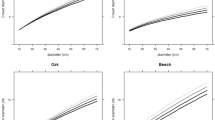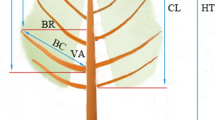Abstract
The objective of the study was to analyse to which extent horizontal crown plasticity reduces inter-tree competition at stand scale, and how it relates to species growth strategy. Two components of crown plasticity defined at the individual tree level (crown shape distortion, CSD and crown displacement relative to stem, CRD) were analysed and their relative importance in the reduction of competition was quantified. Inter-tree competition at stand scale was estimated using spatial pattern analysis and crown overlap estimation. Measurements were performed in a mixed broadleaved stand of Western Europe. Crown plasticity was shown to regularise the spatial distribution of crowns in comparison with the corresponding stems and to reduce inter-tree competition by optimising space occupation. A significant reduction in crown overlap was observed, mainly due to CRD and secondarily to CSD. At the species level, CSD and CRD were positively correlated. In addition, both were negatively correlated with species shade-tolerance scores. In particular, three European temperate tree species showed contrasting responses, which were related to their known specific ecological strategies. Fagus sylvatica, known to be a highly shade-tolerant species, showed large crowns, low CSD and CRD, indicating a low plasticity and suggesting a strong competitive ability. At the opposite, Quercus sp., known to be clearly less shade-tolerant, exhibited a reduced growth, associated with high CSD and CRD, indicating high crown plasticity and probably a lower competitive ability. For this species, plasticity could be described as passive. Last, Carpinus betulus, known to have a relatively good shade-tolerance, showed a contrasting behaviour with high CSD and CRD and a strong presence in the stand, suggesting high crown plasticity and a good competitive ability. In that case, plasticity was described as rather adaptive.








Similar content being viewed by others
References
Baddeley A, Turner R (2005) Spatstat: an R package for analyzing spatial point patterns. J Stat Softw 12:1–42
Bartelink HH (1997) Allometric relationships for biomass and leaf area of beech (Fagus sylvatica L.). Ann For Sci 54:39–50
Besag J (1977) Contribution to the discussion of Dr Ripley’s paper. J R Stat Soc B 39:193–195
Brisson J (2001) Neighborhood competition and crown asymmetry in Acer saccharum. Can J For Res 31:2151–2159
Chambel MR, Climent J, Alía R, Valladares F (2005) Phenotypic plasticity: a useful framework for understanding adaptation in forest species. Invest Agrar Sist Recur For 14:334–344
Crawley MJ (2007) The R book. Wiley, New York, p 942
Cressie NAC (1993) Statistics for spatial data. Wiley Series in Probability and mathematical statistics
Fraley C, Raftery A, Scrucca L (2012) Package ‘mclust’ version 4.0: Normal mixture modeling for model-based clustering, classification, and density estimation. http://cran.r-project.org/web/packages/mclust/index.html
Frech A, Leuschner C, Hagemeier M, Hölscher D (2003) Nachbarschaftsbezogene Analyse des Kronenraumbesetzung von Esche, Hainbuche und Winterlinde in einem artenreichen Laubmishwald (Nationalpark Hainich, Thüringen). Forstw Centralblatt 122:22–35
Goreaud F (2000) Apports de l’analyse de la structure spatiale en forêt tempérée à l’étude et la modélisation des peuplements complexes. Ph.D. thesis, Ecole Nationale du Génie Rural, des Eaux et des Forêts, France
Goreaud F, Pélissier R (2003) Avoiding misinterpretation of biotic interactions with the intertype K-12-function: population independence vs. random labelling hypotheses. J Veg Sci 14:681–692
Hein S, Dhôte JF (2006) Effect of species composition, stand density and site index on the basal area increment of oak trees (Quercus sp.) in mixed stands with beech (Fagus sylvatica L.) in northern France. Ann For Sci 63:457–467
Ishizuka M (1984) Spatial pattern of trees and their crowns in natural mixed forests. Jpn J Ecol 34:421–430
Koukoulas S, Blackburn GA (2005) Spatial relationships between tree species and gap characteristics in broad-leaved deciduous woodland. J Veg Sci 16:587–596
Lang AC, Härdtle W, Bruelheide H, Geißler C, Nadrowski K, Schuldt A, Yu M, von Oheimb G (2010) Tree morphology responds to neighbourhood competition and slope in species-rich forests of subtropical China. For Ecol Manage 260:1708–1715
Le Duc MG, Havill DC (1998) Competition between Quercus petraea and Carpinus betulus in an ancient wood in England: seedling survivorship. J Veg Sci 9:873–880
Lemée G (1990) Les réserves biologiques de la Tillaie et du Gros Fouteau en forêt de Fontainebleau, écocomplexes climaciques. Bulletin de la Société Botanique de France, Lettres Botaniques 1(137):47–62
Leuschner C, Hertel D, Coners H, Büttner V (2001) Root competition between beech and oak: a hypothesis. Oecologia 126:276–284
Longuetaud F, Seifert T, Leban JM, Pretzsch H (2008) Analysis of long-term dynamics of crowns of sessile oaks at the stand level by means of spatial statistics. For Ecol Manage 255:2007–2019
Lotwick HW, Silverman BW (1982) Methods for analyzing spatial processes of several types of points. J R Stat Soc B44:403–413
Montes F, Cañellas I, del Río M, Calama R, Montero G (2004) The effects of thinning on the structural diversity of coppice forests. Ann For Sci 61:771–779
Muth CC, Bazzaz FA (2002) Tree canopy displacement at forest gap edges. Can J For Res 32:247–254
Muth CC, Bazzaz FA (2003) Tree canopy displacement and neighborhood interactions. Can J For Res 33:1323–1330
Niinemets U, Valladares F (2006) Tolerance to shade, drought, and waterlogging of temperate Northern hemisphere trees and shrubs. Ecol Monogr 76:521–547
Ohser J (1983) On estimators for the reduced second moment measure of point processes. Mathematische Operationsforschung und Statistik, series Statistics 14:63–71
Olesen T (2001) Architecture of a cool-temperate rain forest canopy. Ecology 82:2719–2730
Pardé J (1981) De 1882 à 1976/80 : les places d’expérience de sylviculture du hêtre en forêt domaniale de Haye. Revue Forestière Française XXXIII:41–64
Perry GLW, Miller BP, Enright NJ (2006) A comparison of methods for the statistical analysis of spatial point patterns in plant ecology. Plant Ecol 187:59–82
Piboule A, Collet C, Frochot H, Dhôte JF (2005) Reconstructing crown shape from stem diameter and tree position to supply light models. I. Algorithms and comparison of light simulations. Ann For Sci 62:645–657
Picard N, Bar-Hen A, Mortier F, Chadoeuf J (2009) Understanding the dynamics of an undisturbed tropical rain forest from the spatial pattern of trees. J Ecol 97:97–108
Planchais I, Sinoquet H (1998) Foliage determinants of light interception in sunny and shaded branches of Fagus sylvatica (L.). Agric For Meteorol 89:241–253
Pretzsch H, Schütze G (2005) Crown allometry and growing space efficiency of Norway spruce (Picea abies L Karst.) and European beech (Fagus sylvatica L.) in pure and mixed stands. Plant Biol 7:628–639
Pretzsch H, Bielak K, Block J, Bruchwald A, Dieler J, Ehrhart HP, Kohnle U, Nagel J, Spellmann H, Zasada M, Zingg A (2013) Productivity of mixed versus pure stands of oak (Quercus petraea (MATT.) LIEBL. and Quercus robur L.) and European beech (Fagus sylvatica L.) along an ecological gradient. Eur J For Res 132:263–280
Purves DW, Lichstein JW, Pacala SW (2007) Crown plasticity and competition for canopy space: a new spatially implicit model parameterized for 250 North American tree species. PLoS One 9:e870
R Development Core Team (2011) R: a language and environment for statistical computing
Ripley BD (1976) The second order analysis of stationary point process. J Appl Probab 13:255–266
Ripley BD (1977) Modelling spatial patterns. J R Stat Soc B 39:172–212
Ripley BD (1988) Statistical inference for spatial processes. Cambridge University Press, Cambridge
Schröter M, Härdtle W, von Oheimb G (2012) Crown plasticity and neighborhood interactions of European beech (Fagus sylvatica L.) in an old-growth forest. Eur J For Res 131:787–798
Seidel D, Leuschner C, Müller A, Krause B (2011) Crown plasticity in mixed forests—quantifying asymmetry as a measure of competition using terrestrial laser scanning. For Ecol Manage 261:2123–2132
Song B, Chen JQ, Silbernagel J (2004) Three-dimensional canopy structure of old-growth Douglas-fir forest. Forest Sci 50:376–386
Stoll P, Schmid B (1998) Plant foraging and dynamic competition between branches of Pinus sylvestris in contrasting light environments. J Ecol 86:934–945
Strauss-Debenedetti S, Bazzaz FA (1991) Plasticity and acclimation to light in tropical moraceae of different successional positions. Oecologia 87:377–387
Strauss-Debenedetti S, Bazzaz F (1996) Photosynthetic characteristics of tropical trees along successional gradients. In: Mulkey SS, Chazdon RL, Smith AP (eds) Tropical forest plant ecophysiology. Chapman and Hall, New York, pp 162–186
Sultan SE (2000) Phenotypic plasticity for plant development, function and life history. Trends Plant Sci 5:537–542
Umeki K (1995) Importance of crown position and morphological plasticity in competitive interaction in a population of Xanthium canadense. Ann Bot 75:259–265
Valladares F, Niinemets U (2007) The architecture of plant crowns: from design rules to light capture and performance. Functional plant ecology. Taylor and Francis, New York
Valladares F, Niinemets U (2008) Shade tolerance, a key plant feature of complex nature and consequences. Annu Rev Ecol Evol Syst 39:237–257
Valladares F, Chico J, Aranda I, Balaguer L, Dizengremel P, Manrique E, Dreyer E (2002) The greater seedling high-light tolerance of Quercus robur over Fagus sylvatica is linked to a greater physiological plasticity. Trees Struct Funct 16(6):395–403
Valladares F, Gianoli E, Gomez JM (2007) Ecological limits to plant phenotypic plasticity. New Phytol 176:749–763
Vincent G, Harja D (2008) Exploring ecological significance of tree crown plasticity through three-dimensional modeling. Ann Bot 101:1221–1231
Ward JS, Parker GR, Ferrandino FJ (1996) Long-term spatial dynamics in an old-growth deciduous forest. For Ecol Manage 83:189–202
Young TP, Hubbell SP (1991) Crown asymmetry, treefalls, and repeat disturbance of broad-leaved forest gaps. Ecology 72:1464–1471
Acknowledgments
The authors thank Bruno Garnier, Michel Pitsch and Léon Wehrlen for assistance in the field. Thanks are also extended to two anonymous reviewers for their constructive and helpful comments on an earlier manuscript.
Author information
Authors and Affiliations
Corresponding author
Additional information
Communicated by A. Weiskittel.
Rights and permissions
About this article
Cite this article
Longuetaud, F., Piboule, A., Wernsdörfer, H. et al. Crown plasticity reduces inter-tree competition in a mixed broadleaved forest. Eur J Forest Res 132, 621–634 (2013). https://doi.org/10.1007/s10342-013-0699-9
Received:
Revised:
Accepted:
Published:
Issue Date:
DOI: https://doi.org/10.1007/s10342-013-0699-9




